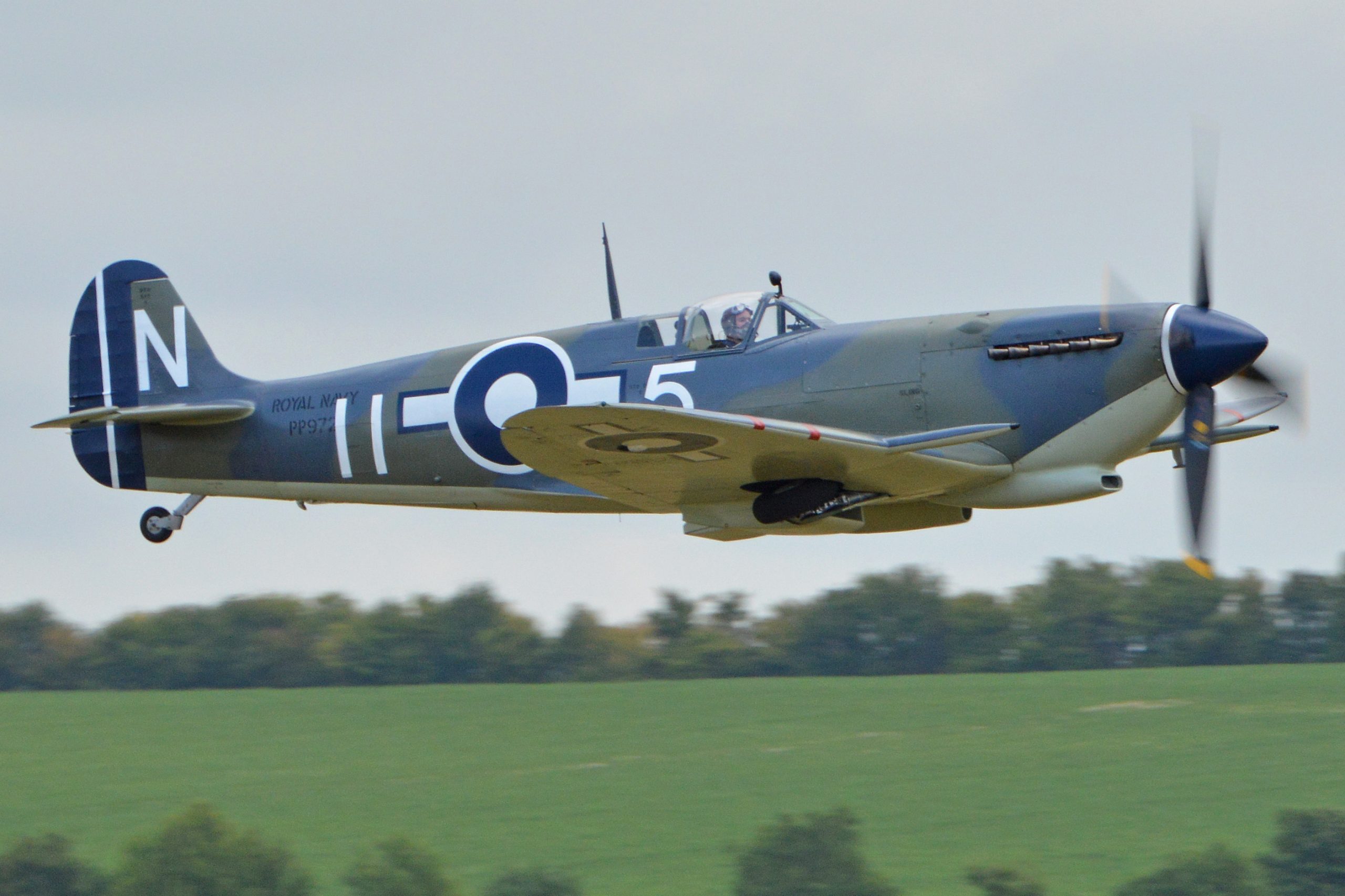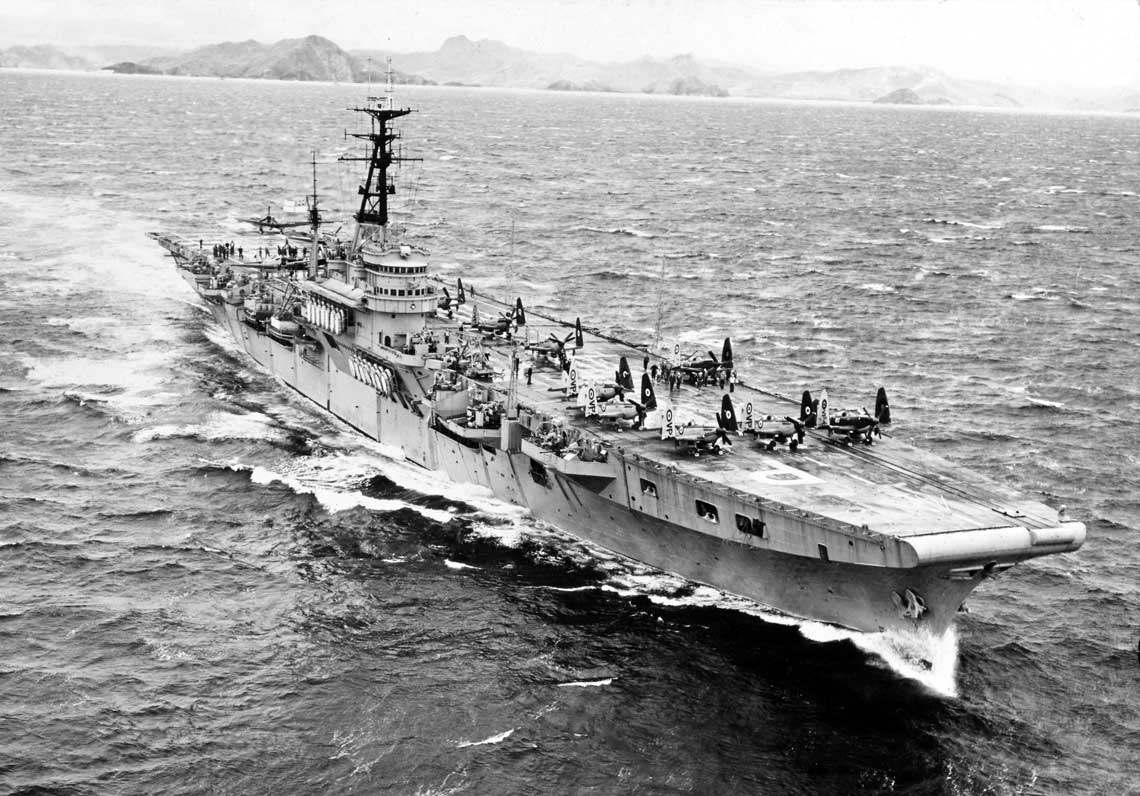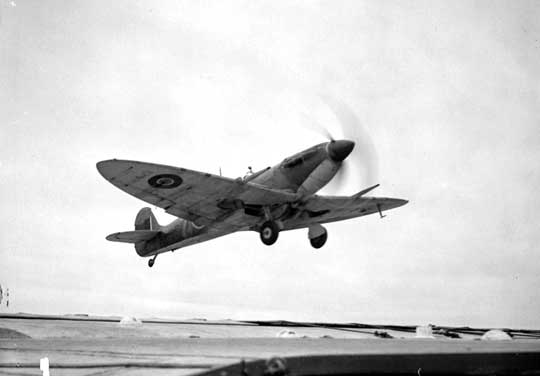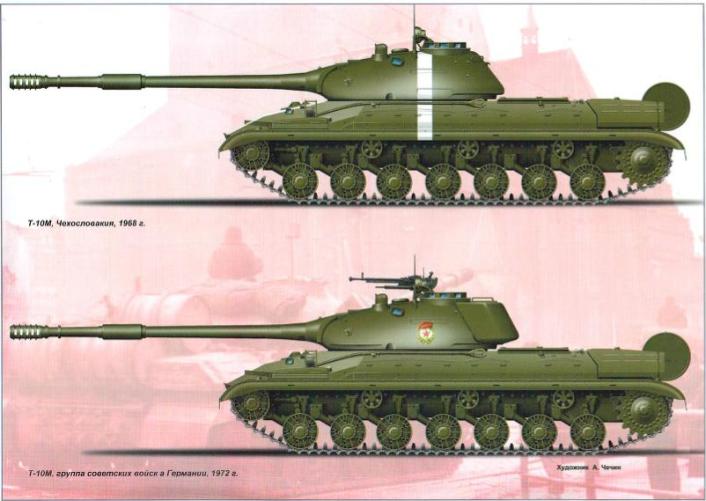
Supermarine Seafire ch.2

The light aircraft carrier HMS Triumph photographed in Subic Bay in the Philippines during maneuvers involving the US Navy in March 1950, shortly before the start of the Korean War. At the bow of the FR Mk 47 Seafire 800th AH, at the stern - Fairey Firefly aircraft.
Almost from the beginning of its career in the Royal Navy, the Seafire was successively replaced by fighters with greater combat potential and better suited for service on aircraft carriers. However, she remained with the British Navy long enough to take part in the Korean War.
Northern France
Due to the delay in the entry into service of HMS Indefatigable - the aircraft carrier of the new Implacable fleet - the waiting Seafire squadrons from the 24th Fighter Wing (887th and 894th NAS) found themselves another occupation. Based at RAF Culmhead in the English Channel, they traveled over Brittany and Normandy, either conducting "combat reconnaissance" or escorting Hawker Typhoon fighter-bombers. Between April 20 and May 15, 1944, they made a total of 400 flights over France. They attacked encountered ground and surface targets, losing two aircraft from air defense fire (one from each squadron), but never collided with the enemy in the air.
In the meantime, it was decided that the 3rd Naval Fighter Wing would be more useful than at sea in directing naval artillery fire during the forthcoming invasion of Normandy. Experience from previous landings had shown that Navy seaplanes on this mission were too vulnerable to attack by enemy fighters. In April, the 886. NAS and 885 were specially "resurrected" for this occasion. The NAS were equipped with the first Seafires L.III, and the 808th and 897th NAS were equipped with Spitfires L.VB. The third wing, expanded and thus equipped, consisted of 3 aircraft and 42 pilots. Together with two RAF squadrons (60 and 26 Squadrons) and one US Navy squadron equipped with Spitfires (VCS 63), they formed the 7th Tactical Reconnaissance Wing stationed at Lee-on-Solent near from Portsmouth. Lieutenant R. M. Crosley of 34 USA recalled:
At 3000 feet [915 m], the Seafire L.III had 200 more horsepower than the Spitfire Mk IX. It was also 200 pounds [91 kg] lighter. We further lightened our Sifires by removing half of their ammunition load and a couple of remote machine guns. Aircraft modified in this way had a tighter turning radius and higher roll and roll rates than Mk IX Spitfires up to 10 feet [000 m]. This advantage will be very useful to us soon!
Crosley mentions that their Seafire had their wingtips removed. This resulted in a much higher roll rate and a slightly higher top speed, but had an unexpected side effect:
We were told that we would be well protected from the Luftwaffe by a constant patrol of 150 other fighters, stacked at 30 feet [000 9150 m]. But we had no idea how boring it must have been for all those RAF and USAAF fighter pilots. During the first 72 hours of the invasion, not a single ADR [air direction radar] tracked down their enemies, whom they could not see for themselves anywhere as far as the eye could see. So they looked down out of curiosity. They saw us circling two by two around the bridgeheads. Sometimes we ventured 20 miles inland. They saw our angular wingtips and mistook us for German fighters. Although we had large black and white stripes on the wings and fuselage, they attacked us again and again. In the first three days of the invasion, nothing we said or did could stop them.
Another threat our navies knew all too well was anti-aircraft fire. The weather on D forced us to fly at an altitude of only 1500 feet [457 m]. Meanwhile, our army and navy were firing at everything that was within reach, and that is why, and not at the hands of the Germans, we suffered such heavy losses on D-Day and the next day.
On the first day of the invasion, Crosley twice directed the fire on the battleship Warspite. The radio communication of the "spotters" with the ships on the English Channel was often disrupted, so the impatient pilots took the initiative and arbitrarily fired at the targets they met, flying under the dense fire of the Polish air defense, this time the German one. By the evening of June 6, 808, 885, and 886, the US had lost one aircraft each; Two pilots (S/Lt HA Cogill and S/Lt AH Bassett) were killed.
Worse, the enemy realized the importance of "spotters" and on the second day of the invasion, Luftwaffe fighters began to hunt for them. Commander Lieutenant S.L. Devonald, commander of the 885th NAS, defended against attacks by eight Fw 190s for ten minutes. On the way back, his badly damaged aircraft lost an engine and had to take off. In turn, Commander J. H. Keen-Miller, commander of the base at Lee-on-Solent, was shot down in a collision with six Bf 109s and taken prisoner. In addition, the 886th NAS lost three Seafires to airsoft fire. One of them was L/Cdr PEI Bailey, a squadron leader who was shot down by Allied artillery. Being too low for standard parachute use, he opened it in the cockpit and was hauled out. He woke up on the ground, badly battered, but alive. South of Evrecy, Lieutenant Crosley surprised and shot down a single Bf 109, presumably from a reconnaissance unit.
On the morning of the third day of the invasion (June 8) over Ulgeit, Lieutenant H. Lang 886 of the NAS was attacked from the forehead by a pair of Fw 190s and shot down one of the attackers in a quick skirmish. A moment later, he himself received a blow and was forced to make an emergency landing. Lieutenant Crosley, who commanded the fire on the battleship Ramillies that day, recalled:
I was just looking for the target we were given when a swarm of Spitfires attacked us. We dodged, demonstrating the stigma. At the same time, I called on the radio to Ramilis to stop. The sailor on the other side obviously did not understand what I was talking about. He kept telling me "wait, ready". At this time, we were chasing each other, as if on a big carousel, with thirty Spitfires. Some of them were obviously shooting not only at us, but also at each other. It was very scary, because “ours” generally shot better than snags and showed much more aggression. The Germans, looking at all this from below, must have wondered what we were crazy about.
There were several more skirmishes with Luftwaffe fighters that day and the following days, but without tangible results. As the bridgeheads expanded, the number of potential targets for the fleet decreased, so the "spotters" were instructed to fire less and less. This cooperation intensified again between 27 June and 8 July, when the battleships Rodney, Ramillies and Warspite bombarded Caen. At the same time, Seafire pilots were assigned to deal with miniature Kriegsmarine submarines that threatened the invasion fleet (one of them was badly damaged by the Polish cruiser ORP Dragon). The most successful were the pilots of the 885th American Regiment, who sank three of these miniature ships on July 9th.
The Seafire squadrons completed their participation in the Normandy invasion on 15 July. Shortly thereafter, their 3rd Naval Fighter Wing was disbanded. The 886th NAS was then merged with the 808th NAS, and the 807th with the 885th NAS. Shortly thereafter, both squadrons were re-equipped with Hellcats.

Supermarine Seafire airborne fighter aircraft from 880. NAS taking off from aircraft carrier HMS Furious; Operation Mascot, Norwegian Sea, July 1944
Norway (June-December 1944)
While most of the allied forces in Europe liberated France, the Royal Navy continued to pursue the occupiers in Norway. As part of Operation Lombard, on June 1, US Federal Aviation Administration aircraft took off from a naval convoy near Stadlandet. Ten Victorious Corsairs and a dozen Furious Seafires (801 and 880 US) fired on the escort ships escorting the ships. At that time, the Barracudas were sunk by two German units: Atlas (Sperrbrecher-181) and Hans Leonhardt. C / Lieutenant K.R. Brown, one of the pilots of the 801st NAS, died in an air defense fire.
During Operation Talisman - another attempt to sink the battleship Tirpitz - on July 17, the Sifires from 880 NAS (Furious), 887 and 894 NAS (Indefatigable) covered the ships of the team. Operation Turbine, carried out on August 3 to navigate in the Ålesund area, was unsuccessful due to severe weather conditions. Most of the aircraft from both carriers turned back, and only eight Seafires from the 887th. The US made it to the coast where they destroyed the radio station on the island of Vigra. A week later (August 10, Operation Spawn), the Indefatigable returned with two escort aircraft carriers, whose Avengers had mined the waterway between Bodø and Tromsø. On this occasion, eight Seafire aircraft out of 894. NAS attacked the Gossen airfield, where they destroyed six Bf 110s taken by surprise on the ground and a Würzburg radar antenna.
On 22, 24 and 29 August, as part of Operation Goodwood, the Royal Navy again attempted to disable the Tirpitz hidden in Altafjord. On the first day of the operation, when the Barracudas and Hellcats tried to bomb the battleship, eight Seafires out of 887. The US attacked the nearby Banak airport and seaplane base. They destroyed four Blohm & Voss BV 138 flying boats and three seaplanes: two Arado Ar 196s and a Heinkla He 115. Lieutenant R. D. Vinay was shot down. In the afternoon of the same day, Lieutenant H. T. Palmer and s / l R. Reynolds of 894. The USA, while patrolling at the North Cape, reported the shooting down of two BV 138 aircraft in a short time. The Germans recorded the loss of only one. It belonged to 3./SAGr (Seaufklärungsgruppe) 130 and was under the command of a lieutenant. August Elinger.
The next Royal Navy foray into Norwegian waters on 12 September was Operation Begonia. Its purpose was to mine the shipping lanes in the Aramsund area. While the Avengers of the escort aircraft carrier Trumpeter dropped their mines, their escorts - 801st and 880th US - were looking for a target. She attacked a small convoy, sinking two small escorts, Vp 5105 and Vp 5307 Felix Scheder, with artillery fire. S/Lt MA Glennie of 801 NAS was killed in an air defense fire.
During this period, the 801st and 880th NAS were to be stationed on the fleet's new aircraft carrier, HMS Implacable. However, its entry into service was delayed, so during the operation "Begonia" both squadrons returned to the "Fast and the Furious", for which this was the last flight in his long career. Then they moved to a land base, where they were officially formed into the 30th Naval Fighter Aviation Regiment. At the end of September, the 1th Wing (24th and 887th NAS) also went ashore, and their aircraft carrier Indefatigable (of the same type as Implacable) returned to the shipyard for minor modernization. Therefore, when Implacable reported readiness for service shortly thereafter, the 894th Wing was temporarily boarded as the more experienced aircraft carrier of this type.
The purpose of their first joint voyage, which took place on October 19, was to explore the Tirpitz anchorage and determine if the battleship was still there. This task was carried out by two-seat Firefly fighters; at the time, the Seafires provided cover for the team's ships. The second and last foray by the 24th Wing aboard Implacable was Operation Athletic, which aimed to pass into the areas of Bodø and Lödingen. On the second day of the operation, October 27, the Sifires covered the Barracuda and Firefly aircraft, which destroyed the U-1060 submarine with rocket salvos. For the 24th Wing, this was the last operation in European waters - shortly after, Indefatigable took them to the Far East.
Implacable returned to Norwegian waters on 27 November with her 30th Fighter Wing (US 801st and 880th) aboard. Operation Provident was aimed at shipping in the Rørvik area. Again, the Firefly fighters (which, unlike the Seafires of the Second World War, were armed with four 20-mm cannons and eight missiles) and Barracuda fighters became the main striking force. During another sortie (Operation Urban, December 7-8), the purpose of which was to mine the waters in the Salhusstremmen area, the ship was damaged as a result of stormy weather. Its repair and reconstruction (including an increase in the positions of small-caliber anti-aircraft artillery) continued until the spring of next year. Only after this did Implacable and his Seafires set sail for the Pacific.
Włochy
At the end of May 1944, squadrons of the 4th Naval Fighter Wing arrived in Gibraltar, embarked on the aircraft carriers Attacking (879 US), Hunter (807 US) and Stalker (809 US). In June and July they guarded convoys between Gibraltar, Algiers and Naples.
However, it soon became clear that at this stage of the war, escort aircraft carriers, more than Seafires, needed aircraft that could be armed with missiles and depth charges to protect convoys from submarines. The old Swordfish biplanes were better suited for this role. For this reason, on June 25, part of the forces of the 4th Wing - 28 L.IIC Seafires from all three squadrons - was transferred to the mainland to interact with the RAF fighter regiments.
This contingent, known as Naval Fighter Wing D, was initially stationed at Fabrica and Orvieto until 4 July and then at Castiglione and Perugia. During this time, he performed, like the Spitfire squadrons he accompanied, tactical reconnaissance tasks, directed artillery fire, attacked ground targets and escorted bombers. He encountered enemy fighters only once - on June 29, two pilots of the 807th took part in a short and unresolved skirmish between Spitfires and a group of about 30 Bf 109 and Fw 190 over Perugia.
The contingent ended its stay in Italy on 17 July 1944, returning via Blida in Algiers to Gibraltar, where it joined the mother ships. In three weeks on the Continent, he lost six Seafires, including three in accidents and one in a night raid on Orvieto, but not a single pilot. S/Lt RA Gowan from 879. USA was shot down by air defense fire and landed over the Apennines, where partisans found him and returned to the unit. S/Lt AB Foxley, also hit from the ground, managed to cross the line before collapsing.
The escort aircraft carrier HMS Khedive arrived in the Mediterranean at the end of July. He brought with him the 899th US Regiment, which had previously served as a reserve squadron. This concentration of forces was intended to support the upcoming landings in southern France. Of the nine aircraft carriers of Task Force 88, Seafires (a total of 97 aircraft) stood on four. These were Attacker (879 US; L.III 24, L.IIC and LR.IIC), Khedive (899 US: L.III 26), Hunter (807 US: L.III 22, two LR.IIC) and Stalker ( 809 USA: 10 L.III, 13 L.IIC and LR.IIC). Of the remaining five aircraft carriers, the Hellcats were placed on three (including two American ones), and the Wildcats on two.
Southern France
Operation Dragoon began on August 15, 1944. It soon became clear that air cover for the invasion fleet and bridgeheads was not necessary in principle, since the Luftwaffe did not feel strong enough to attack them. Therefore, the Sifires began to move inland, attacking traffic on the roads leading to Toulon and Marseille. Aircraft version L.III used their bombing potential. On the morning of August 17, a dozen Seafires from the Attacker and Khedive and four Hellcats from the Imperator aircraft carrier bombed an artillery battery on the island of Port-Cros.
Some of the aircraft carriers of Task Force 88, moving west along the Côte d'Azur, took up position south of Marseille at dawn on 19 August, from where Seafire squadrons were within range of Toulon and Avignon. Here they began to massacre the German army, which was retreating along the roads leading up the Rhone valley. Moving even further west, on 22 August Seafires of Attacker and Hellcats of Emperor disorganized the German 11th Panzer Division encamped near Narbonne. At that time, the remaining Seafires, including them, led the fire of the British (the battleship Ramillies), the French (the battleship Lorraine) and the Americans (the battleship Nevada and the heavy cruiser Augusta), bombarding Toulon, which finally surrendered on August 28.
Seafire squadrons completed their participation in Operation Dragoon the day before. They made as many as 1073 sorties (for comparison, 252 Hellcats and 347 Wildcats). Their combat losses amounted to 12 aircraft. 14 died in landing accidents, including ten crashed aboard the Khedive, whose squadron was the least experienced. Personnel losses were limited to a few pilots. S/Lt AIR Shaw from 879. NAS had the most interesting experiences - was shot down by anti-aircraft fire, captured and escaped. Captured again, he escaped again, this time with the help of two deserters from the German army.
Greece
Following Operation Dragoon, the participating Royal Navy aircraft carriers docked at Alexandria. Soon they were out to sea again. From September 13 to 20, 1944, as part of Operation Exit, they participated in attacks on the evacuating German garrisons of Crete and Rhodes. Two aircraft carriers, Attacker and Khedive, carried Seafires, the other two (Pursuer and Searcher) carried Wildcats. Initially, only the light cruiser HMS Royalist and her accompanying destroyers fought, destroying German convoys at night and retreating under the cover of carrier-based fighters during the day. In the days that followed, Seafires and Wildcats prowled Crete, strafing the island's wheeled vehicles.
At that time, Emperor and his Hellcats joined the band. On the morning of September 19, a group of 22 Seafires, 10 Hellcats and 10 Wildcats attacked Rhodes. The surprise was complete, and all the planes returned unharmed after the bombardment of the main port on the island. The next day, the team headed back to Alexandria. During Operation Sortie, the Sifires made more than 160 sorties and did not lose a single aircraft (in combat or in an accident), which in itself was quite a success.
